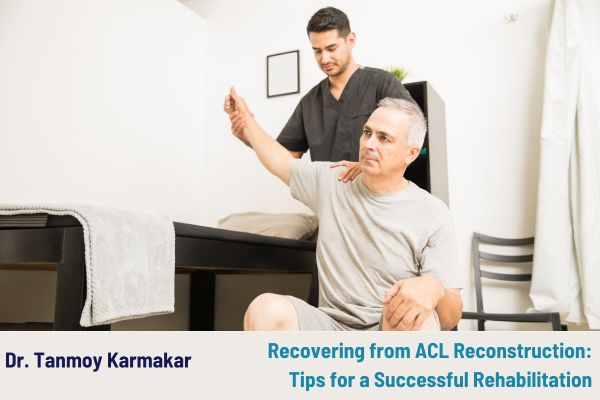
Recovering from ACL Reconstruction: Tips for a Successful Rehabilitation
Anterior Cruciate Ligament (ACL) reconstruction is one of the most common orthopedic surgeries for individuals who experience a torn ACL, often from sports-related injuries. While the surgery itself is a significant step toward recovery, the rehabilitation process plays a crucial role in regaining strength, flexibility, and function. In this blog, we will walk you through the key steps to ensure a successful rehabilitation after ACL reconstruction.
What is ACL Reconstruction?
ACL reconstruction involves replacing the damaged ACL, a key ligament in the knee that helps stabilize the joint, with a tendon from your own body (autograft) or a donor tendon (allograft). The goal of the surgery is to restore knee stability and function, allowing patients to return to their active lifestyles.
However, the road to recovery doesn’t end with surgery. A structured rehabilitation program is necessary to ensure that you heal completely and safely.
Why Is Rehabilitation Important After ACL Reconstruction?
After surgery, your knee will be weakened, and you’ll experience limited mobility. Rehabilitation is essential to help you regain strength, improve range of motion, and return to physical activities. It can also help reduce the risk of re-injury, improve muscle coordination, and prevent knee stiffness.
Here are key steps to ensure that your rehabilitation process is as effective as possible:
- Follow the Post-Surgery Instructions Carefully
Immediately following your ACL reconstruction surgery, your surgeon will provide specific post-operative instructions. This often includes:
- Rest and Elevation: Rest is essential in the first few days following surgery to minimize swelling and promote healing. Elevate your leg whenever possible.
- Ice Therapy: Applying ice to the knee during the first few weeks will help reduce swelling and pain.
- Use of a Knee Brace or Crutches: This may be necessary to support the knee as it heals. Follow your surgeon’s recommendations carefully regarding weight-bearing activities.
- Focus on Range of Motion Exercises
Restoring your knee’s range of motion (ROM) is crucial early in the rehabilitation process. The goal is to avoid stiffness and restore the knee’s normal movement.
Some initial ROM exercises might include:
- Heel Slides: Slowly slide your heel back toward your glutes while lying flat to improve knee bending.
- Quadriceps Sets: Tighten the muscles in your thigh while keeping your leg straight to help improve knee extension.
Your physical therapist will guide you through the most appropriate ROM exercises as you progress.
- Strengthening Exercises
Strengthening the muscles around your knee is one of the most important aspects of rehabilitation. Weak muscles can lead to joint instability and put unnecessary strain on the knee.
Some strengthening exercises include:
- Quad Sets: Contract your quadriceps while your leg is straight. This strengthens the muscles on the front of your thigh.
- Hamstring Curls: Strengthen the back muscles of your thigh by bending your knee while standing.
- Leg Raises: Work on your quadriceps and hip flexors by lifting your leg straight up while lying on your back.
- Step-ups and Squats: Once you’re able to bear more weight, controlled step-ups and squats help strengthen the muscles in your legs and improve balance.
Gradually increase the intensity of these exercises as you gain strength, following the guidance of your physical therapist.
- Balance and Proprioception Training
Proprioception is the body’s ability to sense where it is in space, which plays a critical role in knee stability. Following ACL reconstruction, improving proprioception can help prevent re-injury, especially during high-impact activities.
Some exercises to help improve balance include:
- Single-leg Stands: Practice standing on one leg at a time to strengthen your knee and improve balance.
- BOSU Ball Exercises: A BOSU ball can be used for advanced balance training to enhance knee stability and coordination.
- Gradual Return to Sports and Activity
Returning to sports should be a gradual process, with a focus on avoiding high-impact activities until your knee is strong enough. Early on, your physical therapist may have you practice basic movements like walking and light jogging.
You should only return to full sports activities when:
- You have regained full range of motion.
- You have no swelling or pain in the knee.
- You have achieved near-normal strength and endurance.
- Your physical therapist clears you for activity after functional testing (such as agility drills or jumping).
Most athletes are able to return to sports after 6-12 months, depending on the progress of their rehabilitation.
- Stay Consistent with Your Physical Therapy
The key to success after ACL reconstruction is commitment. Your physical therapy program should be followed consistently and diligently to ensure full recovery. This may include attending scheduled therapy sessions, performing home exercises, and listening to your body to avoid overdoing it.
- Manage Expectations and Be Patient
Recovery from ACL reconstruction takes time. It’s essential to manage your expectations and not rush through the process. Each person’s recovery timeline is different, and your physical therapist or surgeon will help guide you along the way.
While it can be frustrating, remember that the more diligent you are with your rehabilitation, the better your chances for a full and successful recovery.
Conclusion
Recovery from ACL reconstruction can be a lengthy process, but it is entirely possible to return to full function with the right rehabilitation plan. By following the advice of your healthcare provider, staying committed to your physical therapy, and focusing on strength, flexibility, and balance, you will set yourself up for success. Take it one step at a time, and soon you’ll be back to the activities you love.